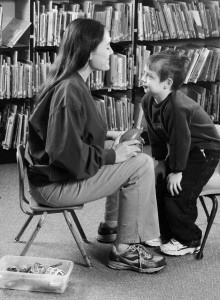
The use of ABA therapy to teach a child with autism has changed the way we look at treatment for these individuals. In the past, some parents were told that these children did not learn and will not function in society. Limited options were given to parents of children with autism such that most children were institutionalized.
As well, mothers in the Bettleheim era were told that they were the cause of autism in their child. With such negative outlooks, it is no wonder that many parents felt hopeless in making a difference in the lives of their children.
Fortunately, Bettleheim’s “refrigerator mother” theory was disproved since autism is found to be a developmental, rather than a psychological, disorder.
Other theories about autism have surfaced since the time of Bettleheim. One such theory, behaviorism, became popular in the 1960’s, since it promoted change in children with autism.
The basic principles on which behaviorism uses is to introduce a stimulus as a method to increase or decrease the likelihood of a behavior. Since autism is objectively characterized by a series of behaviors, theorists of behaviorism felt that by changing maladaptive behaviors and teaching behaviors that were lacking in these children might result in increasing the likelihood of age-appropriate behaviors.
Applied Behavioral Analysis
One such theorist, Ivar O. Lovaas used behaviorism to teach children with autism. As well, he used a form of a teaching strategy called Discrete Trial Teaching (DTT) to maximize learning in children with autism.
In 1987, he organized the Young Autism Project to study the effects of ABA on autistic children under the age of 4 with IQ scores falling in the mild to retarded category.

His experimental group of 19 children received 40 hours a week of one-to-one intensive therapy and a control group only received 10 hours a week.
Lovaas’ short-term goals in an ABA program consisted of teaching compliance, imitation and appropriate toy play, generalizing treatment in the community, and reducing self-stimulatory behaviors such as hand-flapping. In essence, Lovaas was teaching these children skills that they lacked due to their diagnosis.
Long-term goals that were emphasized in years two and three of ABA therapy consisted of teaching language, playing with peers, emotions, pre-academic skills such as reading and writing, and observational learning.
His results revealed that children in the experimental group gained an average of 30 IQ points, and were higher than the control group in school and intellectual functioning.
Of the 19 children in the experimental group, 47% achieved normal or above average IQ scores, went on to a normal first grade, and were indistinguishable from their peers. This is a remarkable statistic considering that before the Lovaas Young Autism Project, the future of autistic individuals was bleak.
Children in the control group had IQ scores that remained stable over time (Lovaas, 1987).
In 1993, McEachin, Smith and Lovaas wanted to evaluate the long-term outcome of the children in Lovaas’ 1987 study.
They found that the 19 children in the experimental group maintained their level of intellectual functioning and had higher scores than the control group on adaptive behavior and personality at a mean age of 11.
The children in the control group did not gain such an outcome. In contrast, they fared poorly, which coincides with the poor prognosis of autistic children if no early intervention was administered.
These two reports prove that ABA is the only scientifically based treatment available at this time for children with autism.
While there are many other therapies out there for children with autism, there is no data to support them. This does not mean that ABA does not incorporate other forms of teaching.
ABA is a broad category that is not specific to children with autism. When it is applied to these children, ABA incorporates DTT, operant conditioning, with the possible use of Picture Exchange Communication (PEC) developed by Andrew Bondy, Ph.D. and Lori Frost, fluency teaching endorsed by Michael Fabrizio, errorless learning developed by Terrace, verbal behavior that is promoted by Dr. Vincent Carbone, Mark Sundberg and Jim Partington, or social stories developed by Carol Gray.
Autism Information References
American Psychiatric Association. (2000). Diagnostic and statistical manual of mental disorders (4th ed. text revision). Washington, DC: Author.
Bondy, A. & Frost, L. (1994). The Picture Exchange Communication System. Focus on Autistic Behavior, 9, 1-19.
Grey, C. (2000). The New Social Stories Book. Future Horizons.
Lovaas, O.I. (1987). Behavioral Treatment and Normal Educational and Intellectual Functioning in Young Autistic Children. Journal of Consulting and Clinical Psychology, 55, 3-9.
Maurice, C. (1993). Let Me Hear Your Voice: A Family’s Triumph Over Autism. New York: Ballantine Books.
McEachin, J., Smith, T., & Lovaas, O.I. (1993). Long-Term Outcome for Children with Autism who Received Early Intensive Behavioral Treatment. American Journal on Mental Retardation, 97, 359-372.
Terrace, H.S. (1966). Stimulus control. In W.K. Honig (Ed.), Operant behavior: Areas of research and application. New York: Appleton-Century-Crofts.
No related posts.
Comments are closed.